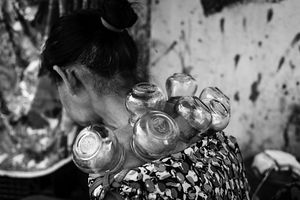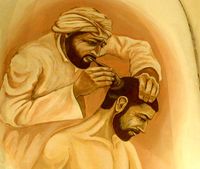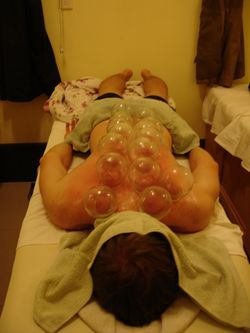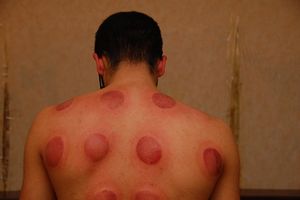Cupping Therapy: Difference between revisions
No edit summary |
No edit summary |
||
| Line 100: | Line 100: | ||
=== Use of cupping in physiotherapy === | === Use of cupping in physiotherapy === | ||
{{#ev:youtube|na3eN1SrhPE&feature=emb_logo | | {{#ev : youtube|na3eN1SrhPE&feature=emb_logo|250}} <ref>The Iowa Clinic.Cupping Therapy | Physical Therapy | The Iowa Clinic. available from : https://www.youtube.com/watch?v=na3eN1SrhPE&feature=emb_logo [last accessed 14/10/2020]</ref> | ||
== References == | == References == | ||
<references /> | <references /> | ||
Revision as of 13:08, 14 October 2020
Original Editor - Chelsea Mclene
Top Contributors - Chelsea Mclene, Rasha Moghanam, Rujuta Naik and Rishika Babburu
Introduction[edit | edit source]
Cupping therapy is one of the oldest and and most effective method of releasing the toxins from body tissue and organs. It is also known as vacuum cupping, hijama cupping, horn treatment etc. It is a practice in which the therapist puts special cups on the skin to create suction. This causes the tissue beneath the cup to be drawn up and swell causing increase in blood flow to affected area. Enhanced blood flow under the cups draws impurities and toxins away from the nearby tissues and organs towards the surface for elimination.[1]
History[edit | edit source]
Cupping is one of the oldest known treatment for multiple illness. Throughout history, cupping techniques and styles have often resembled the geographic locations they were practiced in, as well as utilizing a region’s local materials: animal horns, bamboo, ceramic, glass, metal, and plastic have all been used in this practice found in Ancient Egyptian, Chinese, Unani, Korean, Tibetan, and Latin American cultures, all of which have served the purpose of supporting the body’s ability to heal itself. In North Africa, cupping therapy was first documented on Eber’s papyrus (1550 BCE), where a cup is the Egyptian glyph to reference a physician. In Asia, during the Jin dynasty, Ge Hong (281-341 CE) mentions the use of animal horns as a means of draining fluids from the body.
In Arabic and Islamic countries, cups (Hijama) are recommended in the Al-Qanun Fi’l-Tibb, Canon of Medicine (1025CE), to treat menstrual conditions. Prophet Muhammed is reported to have been a user and also advocated about it.
According to Galen, the principle of indication for blood lenting is to eliminate residues or divert blood from one part to another.
In Chinese medicine, cupping and other similar therapies follow the Daoist model of holism. Holism is the philosophy that systems and their properties must be viewed together, not just as a collection of parts. Daoists contended that no single being or human could exist unless they are seen in relation to nature, as an extension of the universe and as such are impacted by natural phenomenon, such as the seasons and climate, as well as by internal states, such as emotional stress. Disease, according to this concept, is the result of climate, emotions, and/or trauma that create imbalance in the body.[2]
Since Chinese medicinal researchers focus on observable principles of balance examined in living bodies, their traditional medicine practices are considered “alternative” by the dominant medical systems, despite having been practiced for centuries in cultures and countries around the world.
Alternative medicine is defined as “the promotion or use of practices which are unproven, disproven, impossible to prove, or excessively harmful in relation to their effect.” Unfortunately, medicine, particularly Western allopathic medicine, has been viewed solely from an epistemological framework. This framework establishes a theory of knowledge that distinguishes justified belief from opinion. Therefore, evidence-based medicine has been the adopted mode used, predominantly relying on anatomical dissection over any other form of inference or methodology in determining a diagnosis and/or treatment.[3]
Different types of cupping[edit | edit source]
- Dry cupping
- Wet cupping / Hijama
- Oil cupping / Sliding cupping
- Fire cupping
- Moxa cupping
- Horn cupping / Raktamokashan by shrung
- Flash cupping / Empty cupping[4]
- Deep tissue cupping / draining
- Tonifying
- Liquid cupping
- Hot needle cupping
- Accupuncture cupping
- Solar Plexus cupping
- Facial cupping etc
Different types of cups[edit | edit source]
- Horn / suction cups
- Glass / fire glass cups
- Plastic / hijama cups
- Bamboo / wooden cups
- Silicone / facial cups
- Nabhi pump[4]
Indications[edit | edit source]
Cupping therapy is indicated for both healthy patients and those suffering from ailments. Localized ailments that benefit from cupping therapy include a headache, lower back pain, neck pain, and knee pain. Systemic illnesses that have seen benefits with cupping therapy include hypertension, rheumatoid arthritis, diabetes mellitus, mental disorders, heart disease, hypertension, infections, and skin disorders.[5][6]
Contraindications[edit | edit source]
- Excessive dry or cracked skin
- Open wound or ulcer
- Fractured bone
- Dislocated joint
- Bleeding disorders
- Severe anaemia
- Muscle dystrophy
- Patients with fear of blood or bleeding, empty stomach, below 7 years of age (for wet cupping)
- Below 2 years of age for dry cupping
- Abcess
- Excessive swelling[6][7]
Benefits[edit | edit source]
- Cupping helps to reduce pain and inflammation.[8]
- Improves blood flow.
- Used for relaxation, well being and deep tissue massage.
- It is safe, non invasive and inexpensive treatment.[7]
- Rejuvenation of body organs.
- Facilitates healing process and strengthens immune system.
- Used to treat:
- Blood disorders such as anemia and hemophilia
- Rheumatic diseases such as arthritis and fibromyalgia
- Gynecological disorders
- Skin problems: eczema and acne[9]
- High blood pressure
- Migraines, Anxiety and depression
- Varicose veins
Effects[edit | edit source]
- Skin: Improved metabolism in skin tissue, better functioning of sebaceous and sweat glands, improved healing and improved skin resistance.[10]
- Muscles: Stimulates blood flow and lymphatic drainage.
- Joints: Increased blood flow and secretion of synovial fluid.
- Digestive system: Increased peristalsis and secretion of digestive fluids, better digestion and excretion.
- Blood: Improved blood circulation, improved functioning of RBC and WBC.
- Nervous System: Stimulates sensory nerves of skin, Improves ANS.
Side Effects[edit | edit source]
Cupping is a low-risk therapy. The side effects will typically occur during your treatment or immediately after. Lightheadedness or dizziness, sweating or nausea may be experienced.
After treatment, the skin around the rim of the cup may become irritated and marked in a circular pattern. There may be risk of Infection after undergoing cupping therapy and it can be avoided if practitioner follows the right methods for cleaning skin and controlling infection before and after the session.
- Burns from heated cups.
- Fatigue.
- Headaches.
- Muscle tension or soreness.
- Nausea.
- Skin infections, bruising, itching or scarring.[9][11]
Use of cupping in physiotherapy[edit | edit source]
{{#ev : youtube|na3eN1SrhPE&feature=emb_logo|250}} [12]
References[edit | edit source]
- ↑ WebMD. Cupping Therapy. Available from https://www.webmd.com/balance/guide/cupping-therapy#1 [last accessed 14/10/2020]
- ↑ Chirali I Z. Traditional Chinese medicine: cupping therapy. Elsevier Health Sciences.1999.
- ↑ Dinall AM. A reflection on cupping therapy and historical medical dominance. Int J Complement Alt Med. 2019;12(2):66-8.
- ↑ 4.0 4.1 Mehta P, Dhapte V. Cupping therapy: A prudent remedy for a plethora of medical ailments. Journal of traditional and complementary medicine. 2015 Jul 1;5(3):127-34.
- ↑ Nimrouzi M, Mahbodi A, Jaladat AM, Sadeghfard A, Zarshenas MM. Hijamat in traditional Persian medicine: risks and benefits. J Evid Based Complementary Altern Med. 2014 Apr;19(2):128-36.
- ↑ 6.0 6.1 Aboushanab TS, AlSanad S. Cupping therapy: an overview from a modern medicine perspective. Journal of acupuncture and meridian studies. 2018 Jun 1;11(3):83-7.
- ↑ 7.0 7.1 Ilkay Zihni Chirali MBAcC RCHM. Benefits of Cupping Therapy. Traditional Chinese Medicine Cupping Therapy (Third Edition), 2014
- ↑ Timothy Huzar. Medical News Today. What to know about cupping therapy? Available from https://www.medicalnewstoday.com/articles/324817#pain-relief [last accessed 14/10/2020]
- ↑ 9.0 9.1 Healthline. Cupping therapy. Available from https://www.healthline.com/health/cupping-therapy#conditions [last accessed 14/10/2020]
- ↑ Al-Bedah AMN, Elsubai IS, Qureshi NA, et al. The medical perspective of cupping therapy: Effects and mechanisms of action. J Tradit Complement Med. 2018;9(2):90-97. Published 2018 Apr 30. doi:10.1016/j.jtcme.2018.03.003
- ↑ Cleveland Clinic. Cupping: Risks / Benefits. Available from:https://my.clevelandclinic.org/health/treatments/16554-cupping/risks--benefits [last accessed 14/10/2020]
- ↑ The Iowa Clinic.Cupping Therapy | Physical Therapy | The Iowa Clinic. available from : https://www.youtube.com/watch?v=na3eN1SrhPE&feature=emb_logo [last accessed 14/10/2020]










